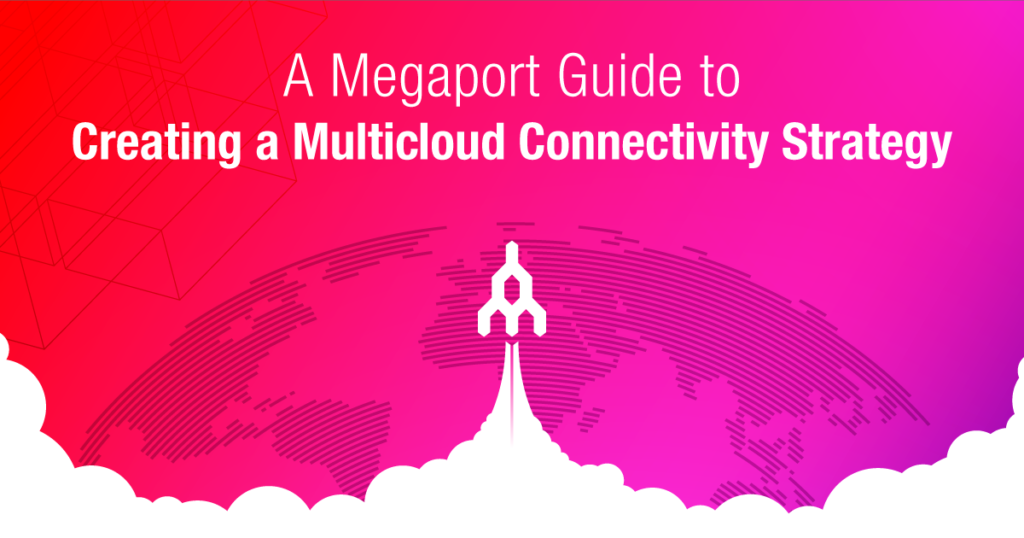
A Megaport Guide to Creating a Multicloud Connectivity Strategy
- August 17, 2018
- RSS Feed
Exploring the advantages of direct connectivity for multicloud and ways to build a smart network architecture.
Most organisations looking to design a multicloud strategy aspire to the benefits that best-of-breed cloud services can bring to their network architecture; flexibility, resilience, cost efficiency, and performance. Others might have come across the idea of multicloud when problem-solving a different issue only to find an opportunity right in front of them. Either way, when considered carefully, a multicloud architecture can transform the way your business manages and accesses data workloads, and ultimately, increase business productivity. Here’s our guide to creating a connectivity strategy that leverages the advantages of multicloud.

1. Think about your workload and service needs before building your architecture.
Firstly, it’s important to consider the following factors in relation to how you’re using your workloads and services: Cloud Location Where should you locate your cloud? Figure out whether or not you have intercloud communication requirements – on a global or regional basis – and where most of your traffic is going; between the cloud and the internet, between on-premisesinfrastructure and cloud environments, or between multiple office locations. Data Privacy and Security How will you remain in resolute control of your information flows between physical sites and from cloud to cloud? Consider whether or not the public internet is secure enough for your customers’ data. Disaster Recovery Do you know how quickly your workloads can reach the recovery time objective (RTO) and the recovery point objective (RPO) in the event of an emergency? If your data centre environment goes down, you might find your data stuck in the cloud or having to overprovision on expensive disaster recovery links during normal operation. Costs The way you use your workload communications inside and outside of the cloud can have a significant effect on costs. Most cloud providers are happy to allow ingress traffic for free but will charge for egress so deploying large database workloads from the cloud could drive up your costs. Service Agility Does your cloud connection model align with the speed, scale, agility, and flexibility you’ve come to expect from your cloud consumption model? 
2. Make dedicated connectivity a fundamental component of your network.
The actual connectivity component of a network is often overlooked as a consideration when moving to multicloud. But, when you think about the requirements it takes to make your cloud strategy effective for your business, connectivity actually weaves its way through every one of them. So, it makes sense to build your multicloud network architecture on a foundation of connectivity that’s direct, private, and highly efficient at getting your data to where it needs to be. Network as a Service (NaaS) providers, like us, offer private network connectivity for direct access to multiple cloud services. Compared to best-effort public internet connections, our Software Defined Network (SDN) enables a fast, flexible, and scalable way to connect and align your network consumption with your cloud consumption along with the ability to adapt these to changing business needs. Not only does this mean increased service agility, with the power to provision connections at sub-rate speeds and scale capacity without limits, our SDN also enables you to realise cost savings on provisioning multiple cloud connections in multiple regions. This allows you to take the complexity out of the above considerations and focus on your organisation’s business strategy. As the NaaS paradigm increasingly becomes the accustomed way of thinking about consuming cloud services, building cloud architectures for the future will only become easier. 
3. Explore alternatives for point-to-point interfaces with cloud providers.
We often get asked by customers why they should connect to cloud providers via Megaport. Quite rightly users want to know if they are going the long way around instead of setting up a point-to-point interface to their chosen cloud provider. Firstly, some providers, such as Microsoft Azure, don’t support a dedicated connection and stipulate a partner connection via Express Route. Most providers offer direct connectivity products for interfacing with their cloud. If you can easily get access to the desired cloud provider’s onramp location and only wish to connect to one provider, using a point-to-point connection may be right for you. Be aware, however, that there are differing prerequisites from each provider that you must fulfill in order to achieve a connection. Provisioning cloud interconnection services on the Megaport Network gives you the ability to access multiple cloud providers from one point. This enables you to design a streamlined multicloud network architecture without the hassle of having to build out and manage many connections to many providers. With Megaport, you also have the option of easy access to multiple cloud on-ramps so you can reach the cloud services you need from wherever you might be. Connections are flexible which makes it easy to connect to a new provider or location within minutes, and then dial your bandwidth up and down to suit your consumption. And finally, flexible IP addressing is available for service provider connections versus direct cloud provider requirements. 
4. Use virtual routing if your organisation is born in the cloud.
Working in multicloud doesn’t inherently create difficulties until you wish to distribute workloads across clouds and require communication between them. If your organisation solely exists in the cloud, this creates challenges for deploying a multicloud network architecture because you don’t own or run a private network, in a physical location, to connect back to. Virtual routing is a concept that solves this challenge by enabling the connectivity of multiple cloud environments allowing you to move workloads between them. This is where Megaport Cloud Router (MCR), our virtual routing service, becomes a useful tool to join disparate systems together with private peering between public cloud, IaaS, and SaaS providers. MCR enables virtual routing capabilities for on-demand, direct Layer 3 connectivity so those without a physical network can connect clouds without having to route back to legacy infrastructure. For example, if you’re working across AWS, Azure, and Google Cloud Platform, you can join all three environments together, between regions, in a matter of minutes. And, you can do this while establishing secure, private, and low-latency connections, with an SLA, for multicloud and multi-region network architectures. When planned and considered, a multicloud connectivity strategy can transform your enterprise organisation with multiple advantages including cost optimisation, the power of choice, and reduced security risks. Dedicated connectivity should form the foundation of your multicloud network architecture; the above guide is designed to help you realise the benefits of multiple cloud services to progress your business now and into the future.





